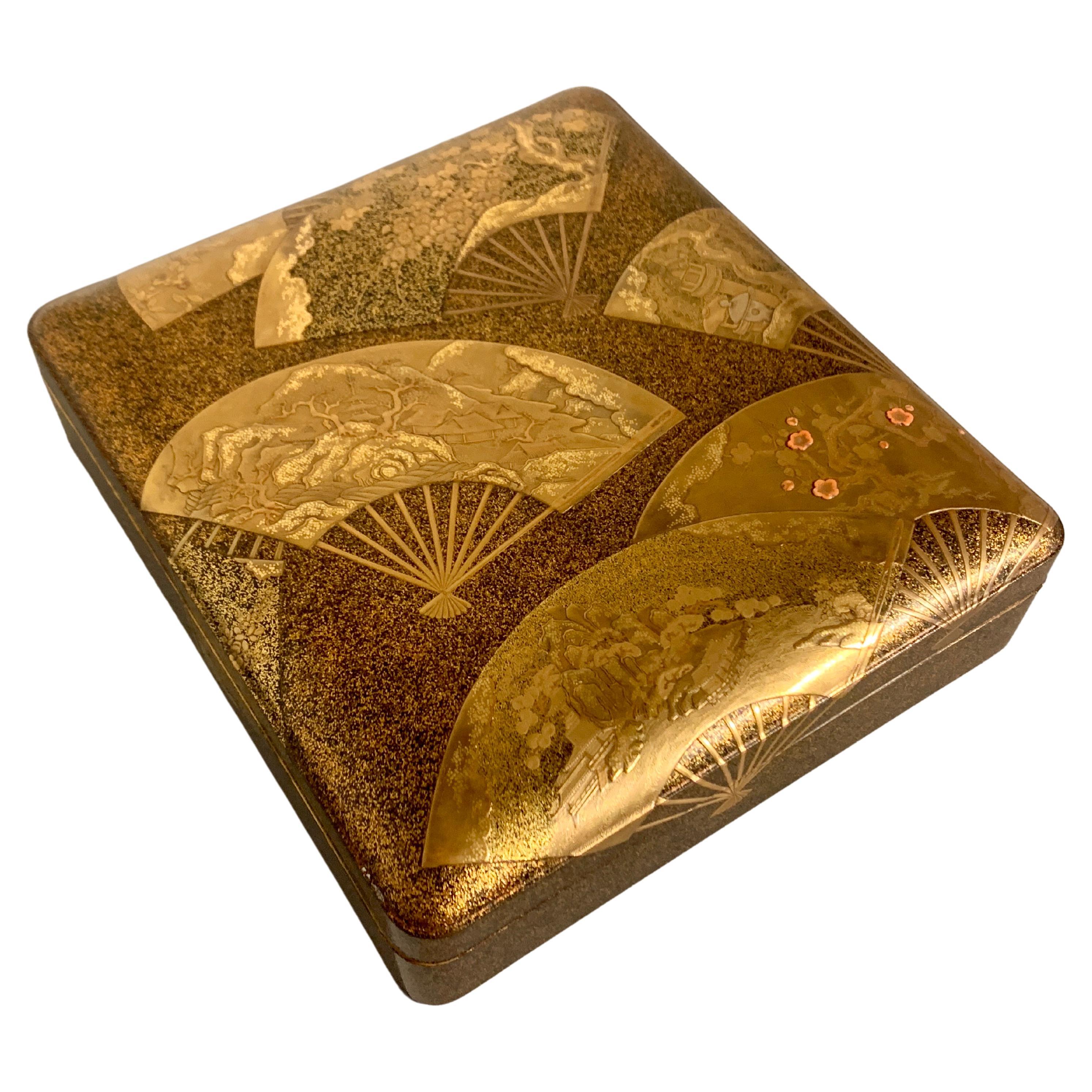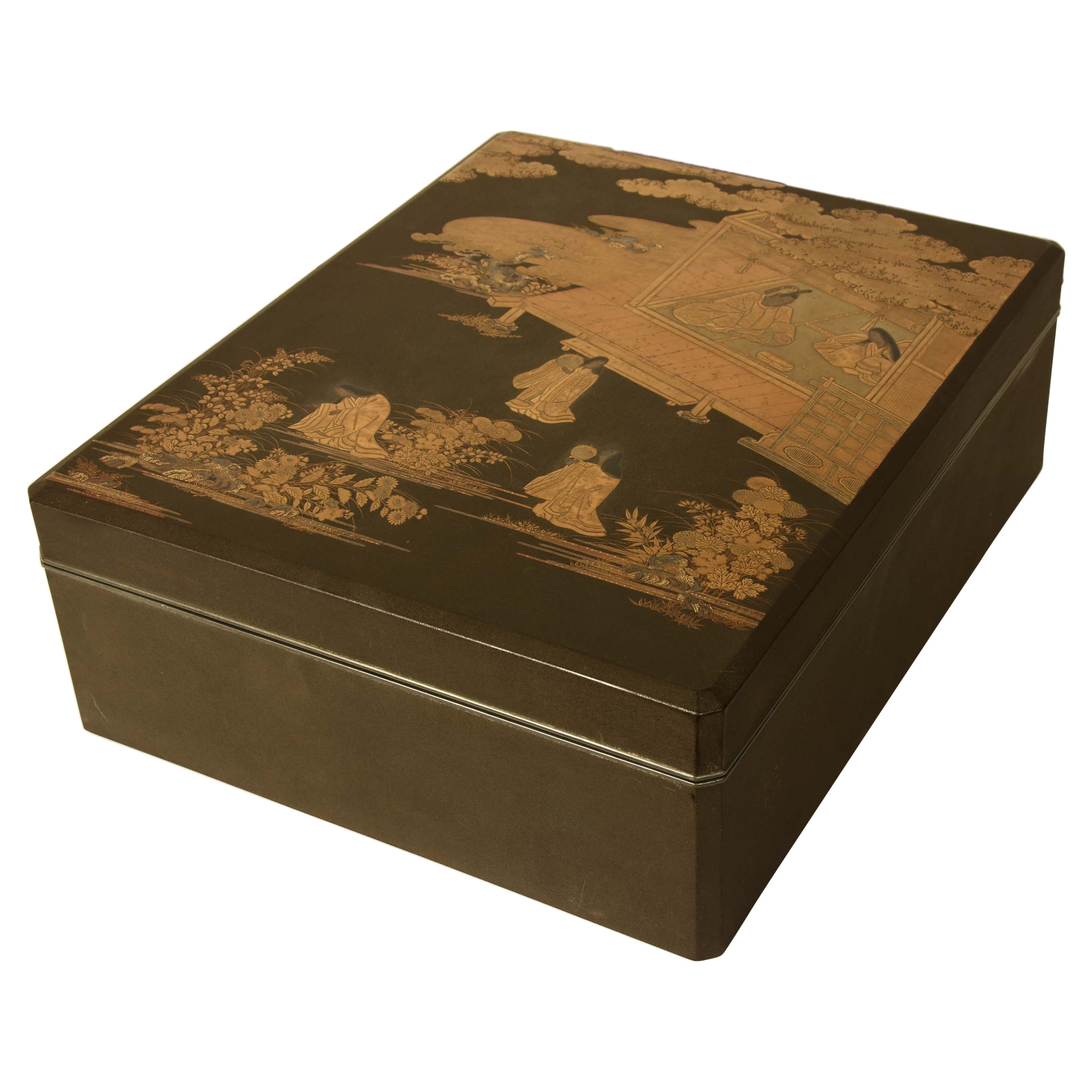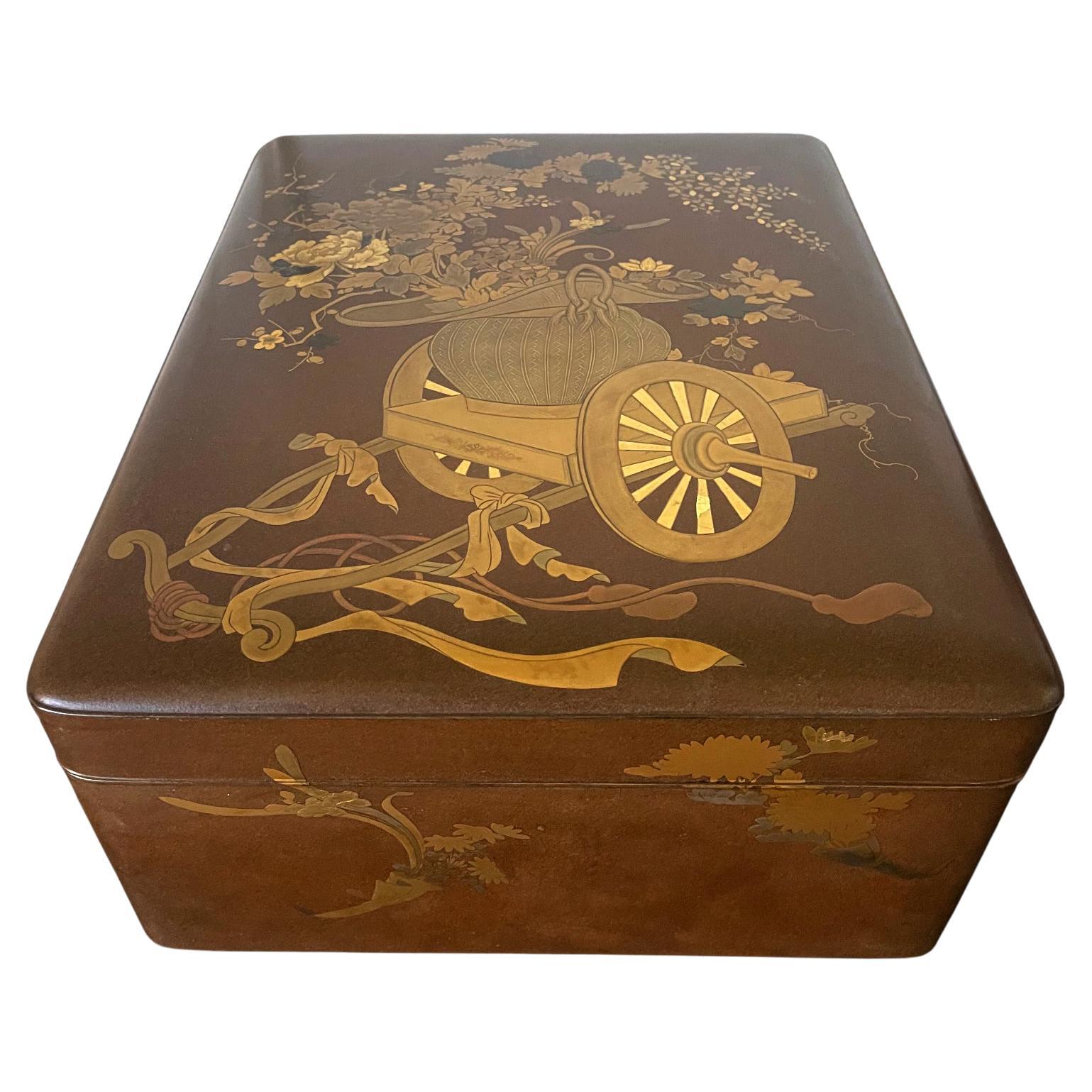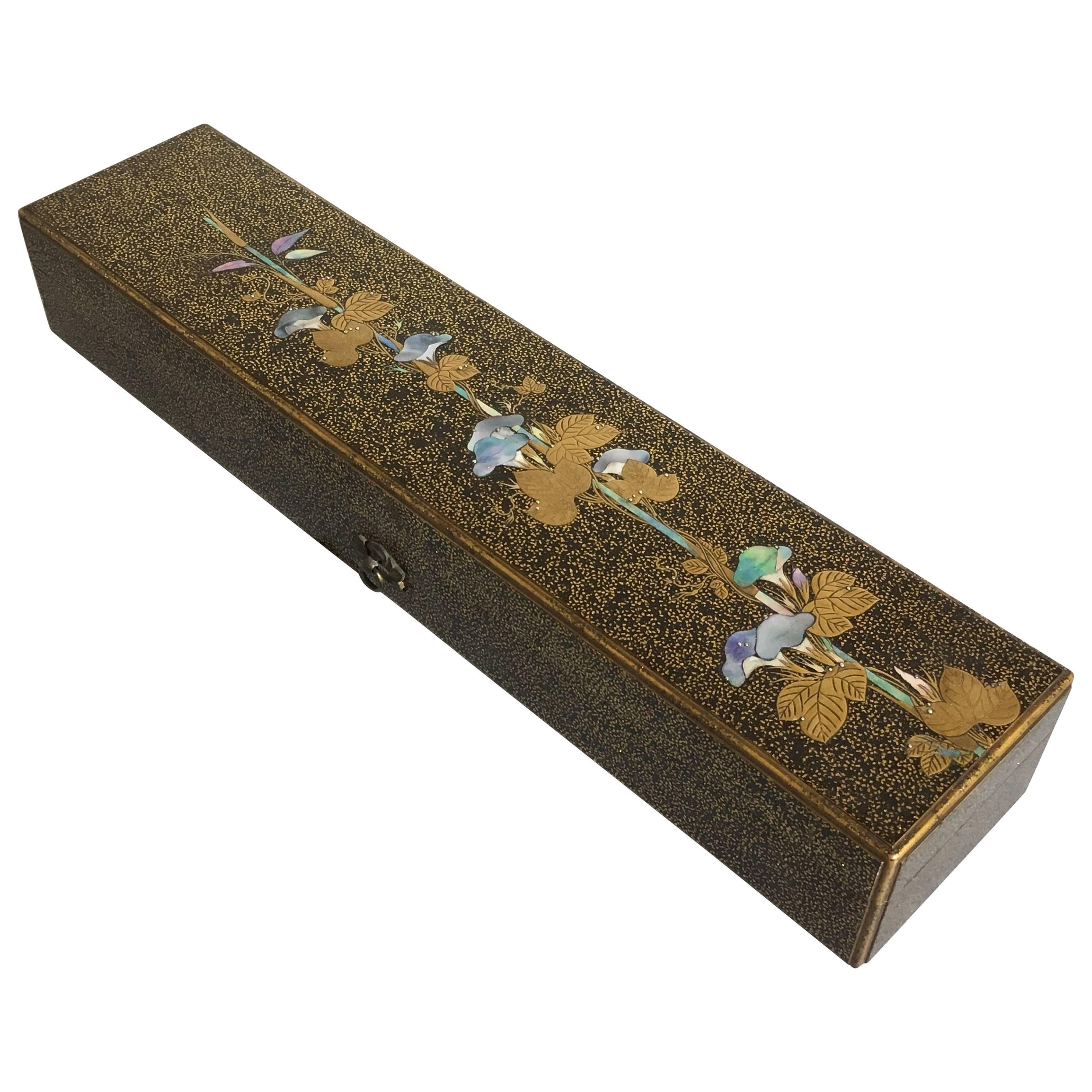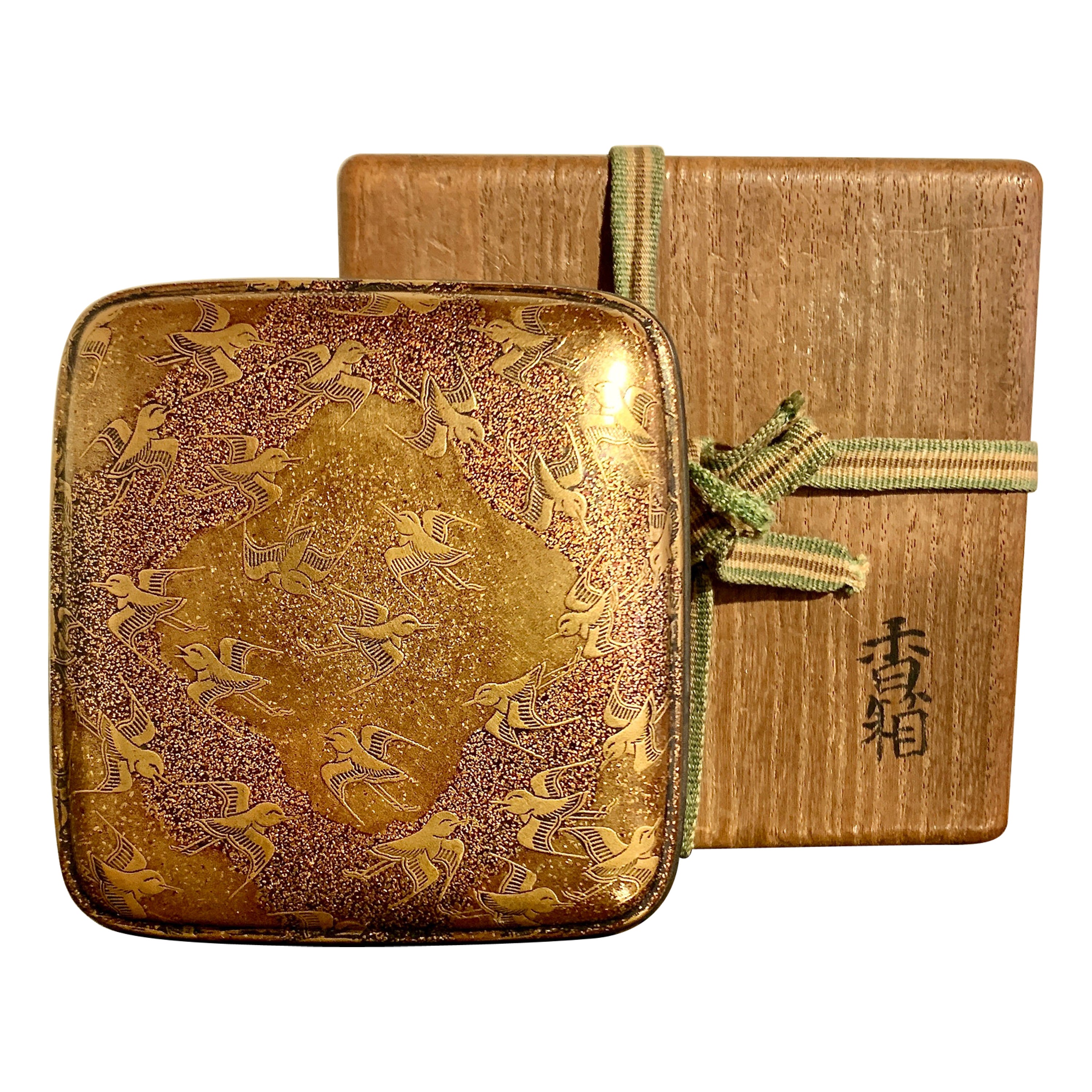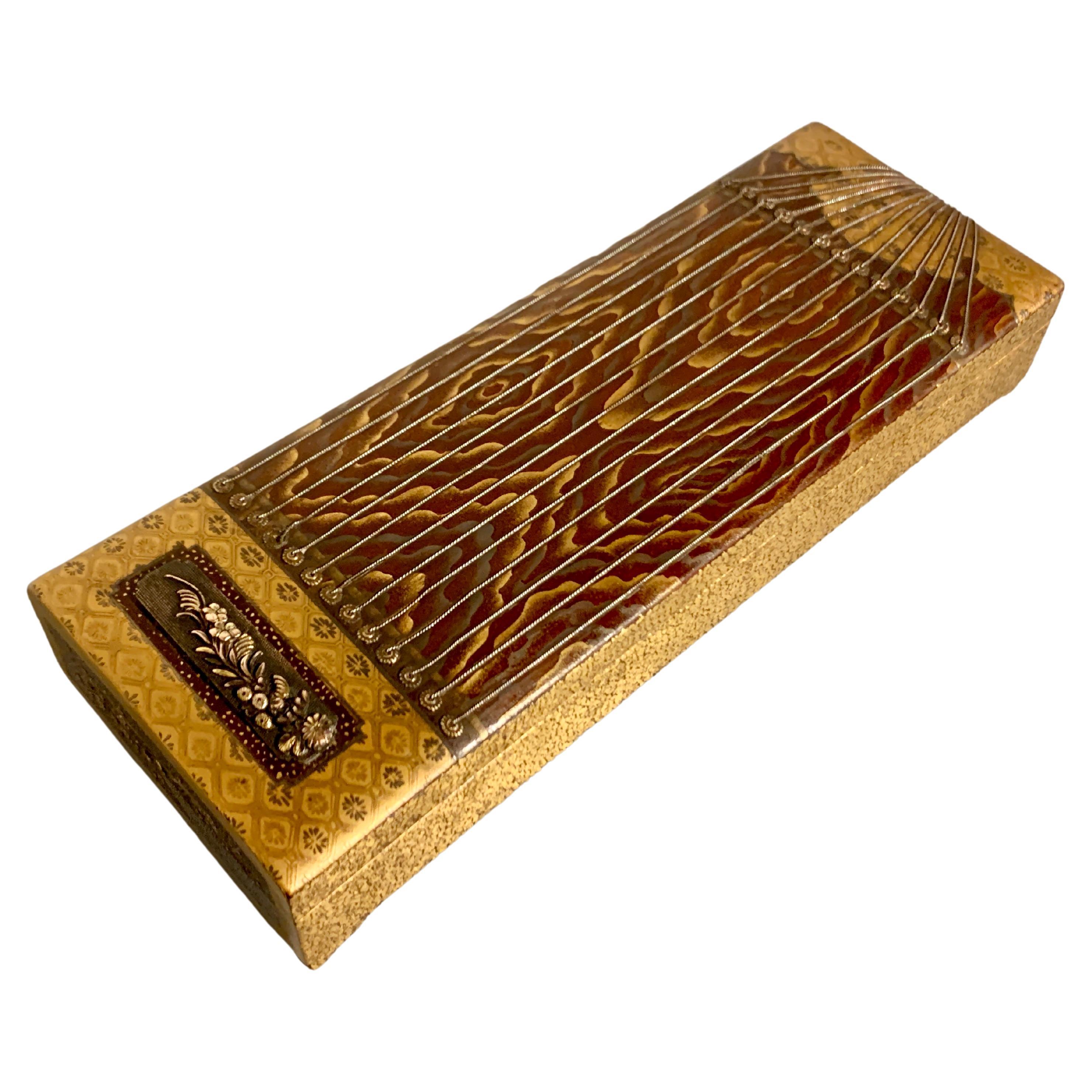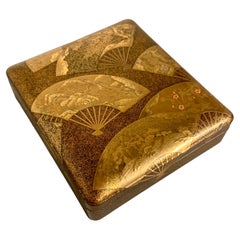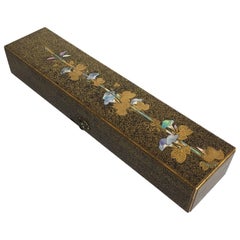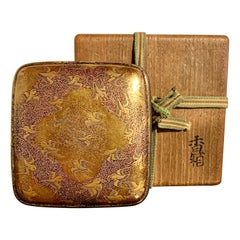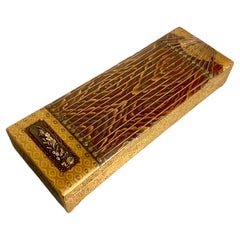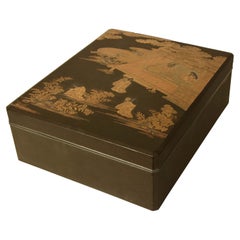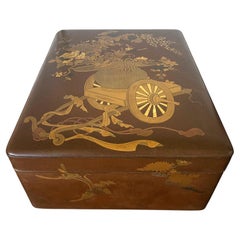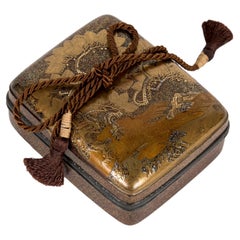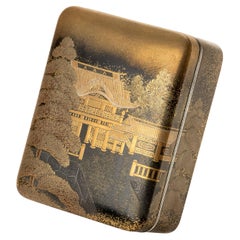Items Similar to Large Japanese Lacquer Document Box, Ryoshibako, Edo/Meiji period, Japan
Want more images or videos?
Request additional images or videos from the seller
1 of 21
Large Japanese Lacquer Document Box, Ryoshibako, Edo/Meiji period, Japan
$27,500
£20,877.53
€23,879.44
CA$38,421.49
A$42,733.08
CHF 22,313.89
MX$520,016.15
NOK 284,982.39
SEK 267,263.21
DKK 178,221.43
Shipping
Retrieving quote...The 1stDibs Promise:
Authenticity Guarantee,
Money-Back Guarantee,
24-Hour Cancellation
About the Item
A large and magnificently decorated Japanese lacquer document box, ryoshibako, signed Umeboshi/Baikyo, late Edo or early Meiji Period, mid 19th century, Japan.
The large document box, ryoshibako, of tall, rectangular shape with rounded corners, and fitted with an inrobuta (flush-fitting) cover with beveled edges. The exterior of this exquisite box is decorated all over with fifteen different raised reserves shaped as uchiwa (paddle) fans against a lush and intricate krikane ground imitating shagreen.
The uchiwa shaped reserves all of takamaki-e, and exquisitely painted with designs of animals, flowers, and landscapes in silver, gold, maki-e, hiramaki-e, and takamaki-e, with kirikane, nashiji, and polychrome embellishments, upon gold lacquer fudame grounds.
The interior of the lid is nothing short of spectacular, featuring a large design of a magnificent and beautifully detailed rooster and hen with chicks gathered around a lazy stream. Large stalks of chrysanthemum bloom behind them. All against an ethereal nashiji ground.
The cover of the box features five reserves:
1. Three minogame (turtles with long tails), symbolizing longevity
2. "Narihira Crossing the Sumida" from The Tales of Ise
3. An onagadori (long tailed rooster) and hen with bamboo
4. Togetsukyo bridge
5. Ming Dynasty style blossoming peony and rocks
The sides of the box features ten reserves:
1. Hawk and pine, symbolizing strength and longevity
2. Crucian carp and river prawn
3. Java sparrow and plum
4. Landscape featuring a lazy stream and dragonflies
5. Butterflies and moths, symbolizing rebirth
6. Landscape of a lazy stream by farmhouse
7. Bamboo blind (sudare) with pear branches and blossoms
8. Landscape with plovers (chidori) flying among crashing waves
9. Landscape with pine and cranes, symbols of longevity
10. Long tailed bird and plum
The difference in style, detail, and composition of these fans indicate they are possibly copies of famous paintings or woodblock prints by various artists.
Signed in gold lacquer Umeboshi or Baikyo, with red kaou seal.
The interior of the box decorated with a rich nashiji lacquer ground. The underside of the box of a more subdued nashiji lacquer ground.
- Dimensions:Height: 5.75 in (14.61 cm)Width: 10 in (25.4 cm)Depth: 13.25 in (33.66 cm)
- Style:Meiji (Of the Period)
- Materials and Techniques:
- Place of Origin:
- Period:
- Date of Manufacture:circa 1860
- Condition:Wear consistent with age and use. Minor losses. Minor fading. In very good condition for age. With some minor surface scratches to the lacquer. Minor wear and loss to the kirikane. Wear to the gold lacquered rims. No damage or repairs noted.
- Seller Location:Austin, TX
- Reference Number:1stDibs: LU894735109762
About the Seller
5.0
Platinum Seller
Premium sellers with a 4.7+ rating and 24-hour response times
Established in 2001
1stDibs seller since 2010
345 sales on 1stDibs
Typical response time: <1 hour
- ShippingRetrieving quote...Shipping from: Austin, TX
- Return Policy
Authenticity Guarantee
In the unlikely event there’s an issue with an item’s authenticity, contact us within 1 year for a full refund. DetailsMoney-Back Guarantee
If your item is not as described, is damaged in transit, or does not arrive, contact us within 7 days for a full refund. Details24-Hour Cancellation
You have a 24-hour grace period in which to reconsider your purchase, with no questions asked.Vetted Professional Sellers
Our world-class sellers must adhere to strict standards for service and quality, maintaining the integrity of our listings.Price-Match Guarantee
If you find that a seller listed the same item for a lower price elsewhere, we’ll match it.Trusted Global Delivery
Our best-in-class carrier network provides specialized shipping options worldwide, including custom delivery.More From This Seller
View AllJapanese Maki-e Lacquer Document Box, Edo Period, early 19th Century, Japan
Located in Austin, TX
A spectacular Japanese maki-e lacquer lidded box, possibly a writing box, suzuribako, decorated with images of folding fans, ogi, Edo Period, earl...
Category
Antique Early 19th Century Japanese Edo Lacquer
Materials
Coral
Japanese Edo Period Igarashi School Long Lacquer Box, Tanzaku-Bako
Located in Austin, TX
A stunning Japanese Edo period lacquer tanzakubako, box for poem cards, late 18th-early 19th century, Edo Period, Japan.
Attributed to the Igarashi School, this box is masterfully ...
Category
Antique Early 19th Century Japanese Edo Lacquer
Materials
Mother-of-Pearl, Lacquer
Japanese Lacquer Incense Box, Kogo, Momoyama or Edo Period, 16th/17th Century
Located in Austin, TX
A wonderful Japanese lacquer incense box, kogo, with a design of plovers in flight, late Momoyama or early Edo Period, circa 1600, Japan.
The small box, called a kogo, was used to s...
Category
Antique Early 17th Century Japanese Edo Lacquer
Materials
Gold, Pewter
Japanese Lacquer Writing Box, Suzuribako, Edo Period, 18th Century, Japan
Located in Austin, TX
An exceptionally fine and unusual Japanese lacquer writing implements box, suzuribako, in the form of a zither, koto, Edo Period, 18th century, Japan. With a modern wood storage box,...
Category
Antique 18th Century Japanese Edo Lacquer
Materials
Gold, Silver, Copper
Japanese Stacking Incense Box, Ju-Kobako, Meiji Period, Mid 19th century, Japan
Located in Austin, TX
An exquisite small Japanese maki-e lacquer stacking box for incense and accessories, ju-kobako, late Edo or early Meiji Period, mid 19th century, Japan.
Crafted in maki-e lacquer an...
Category
Antique Mid-19th Century Japanese Meiji Lacquer
Materials
Silver
Japanese Lacquer Accessories Box, Tebako, Brocade Design, Meiji Period, Japan
Located in Austin, TX
A very fine Japanese lacquer tebako, box for personal accessories, in the form of rolled bolts of brocade fabric, Meiji Period, late 19th century, Japan.
The box is whimsically shap...
Category
Antique Late 19th Century Japanese Meiji Lacquer
Materials
Softwood, Lacquer
You May Also Like
Superb Japanese Black Lacquer Document Box with Gold Maki e Design, Meiji Period
Located in Prahran, Victoria
An antique black lacquer document box with an exquisitely detailed, finely wrought design from The Tale of the Genji depicted in gold maki e across the lid. Internally, the box is de...
Category
Early 20th Century Japanese Lacquer
Materials
Wood, Lacquer
$5,200 Sale Price
20% Off
Japanese Lacquer Ryoshibako Document Box Meiji Period
Located in Atlanta, GA
A large Japanese lacquer box with elaborate Maki-e design from Meiji period, (mid-late 19th century). The generous size of the box was reser...
Category
Antique 19th Century Japanese Japonisme Lacquer
Materials
Wood, Lacquer
Japanese landscape pine kobako box Edo period 18th century
Located in PARIS, FR
Rectangular black and gold lacquer kobako box decorated with pine trees in a mountain landscape in takamaki-e, kirigane and hiramaki-e lacquer. Background in nashi-ji lacquer. Surmou...
Category
Antique 18th Century Japanese Lacquer
Materials
Gold
A Maki-e Lacquer Tebako Box Embellished With Gold Decorations
Located in Milano, IT
Tebako lacquer maki-e box embellished with gold decorations depicting a Buddhist temple surrounded by majestic Matsu pines. The interior and base are finished in nashiji lacquer. The...
Category
Antique 19th Century Japanese Lacquer
Materials
Lacquer
$2,779 Sale Price
20% Off
Exquisite Japanese Lacquer Maki-e Hand Box Kobako Edo Period
Located in Atlanta, GA
An early Japanese lacquer Maki-e decorated kobako (small storage box) circa 18th century (Edo period). Based on its form and size, this kobako was possibly used as a Chabako to store the accoutrements for chado (tea ceremony). The lidded box is of rectangular form with bevel design on all edge that softens the appearance. The entire surface was densely covered with a background of nashiji. Elaborate Maki-e techniques were used on each side to showcase a distinct landscape or floral design within a cartouche panel. On the surface of the lid, a mountainous landscape rises from the edge of the water. The poetic composition is akin to a traditional ink scroll...
Category
Antique 18th Century Japanese Edo Lacquer
Materials
Lacquer
Japanese Lacquered Tebako 'Box'
Located in PARIS, FR
Tebako box with three compartments in golden and nashi-ji lacquer, decorated with golden, red, and kirigane lacquer, golden persimmon tree leaves, among rocks. The compartments are of increasing size from the top. The decoration is in continuity.
Persimmon has been cultivated in southern China for more than 2500 years and is believed to have been introduced to Japan in the 8th century. The veneer is a tree with very hard wood, similar to ebony. According to a legend, one specimen survived the atomic bombing of Nagasaki on August 9, 1945, close to the epicenter. It is therefore in Japan a symbol of strength and longevity. It is also the national fruit of the country. It is eaten as a traditional dish during New Year's Day celebrations.
Tebako literally means "portable box...
Category
Antique 1860s Japanese Lacquer
Materials
Lacquer
More Ways To Browse
Red Lacquer Furniture
Antique Document
Edo Period Japanese Art
Japanese Butterfly
Antique Lacquer Painting
Japanese Fans
Red Lacquer Box
Japanese Fan Art
Japanese Lacquer Boxes
Edo Period Gold
Seal Box
Antique Japanese Seals
Lacquered Large Boxes
Japanese Butterfly Art
Large Lacquer Box
Large Turtle
Japanese Meiji Period Box
Japanese Crane Art
